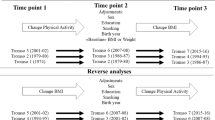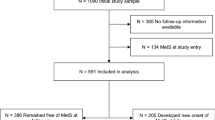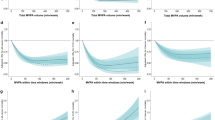Abstract
BACKGROUND: Earlier observational studies of the relation between physical activity and obesity are inconsistent and ambiguous, showing a clear cross-sectional inverse relation, and a prospective association only when physical activity at the time of follow-up is included.
OBJECTIVE: To examine the long-term effect of leisure time physical activity (LTPA) on subsequent development of obesity and the effect of body weight on later physical inactivity in a population-based longitudinal setting taking into account the effects of historical changes on future changes as well as pertinent confounders.
DESIGN: The study included 3653 women and 2626 men aged 20–78 y selected at random within sex–age strata from the general population of Copenhagen. At two surveys, 5 y apart, LTPA, body mass index (BMI) (weight/height2, kg/m2), several possible confounders and modifying factors were assessed. Obesity (defined as BMI ≥30 kg/m2) and LTPA was assessed at the 3rd survey 10 y later. Odds ratios (with 95% confidence limits) for developing obesity between the last two surveys were estimated by logistic regression analysis, taking into account baseline and preceding changes in BMI and LTPA. A similar analysis of odds ratios for physical inactivity as outcome at the 3rd survey was conducted.
RESULTS: Compared to physical inactivity, the odds ratios of development of obesity among women with medium and high level of activity were 0.81 (0.53, 1.25) and 1.16 (0.73, 1.84), respectively, and among men, the odds ratios were 1.28 (0.71, 2.33) and 1.65 (0.91, 2.99), respectively. Compared to median BMI, the odds ratio of later physical inactivity among women with high BMI was 1.91 (1.39, 2.61), and among men the odds ratio was 1.50 (1.01, 2.22). The associations were not confounded or modified by age, pre-existing diseases, smoking, alcohol intake, educational level, occupational physical activity or by familial predisposition to obesity.
CONCLUSION: This study did not support that physical inactivity as reported in the freely living adult population in the long term is associated with the development of obesity, but the study indicates that obesity may lead to physical inactivity.
This is a preview of subscription content, access via your institution
Access options
Subscribe to this journal
Receive 12 print issues and online access
$259.00 per year
only $21.58 per issue
Buy this article
- Purchase on Springer Link
- Instant access to full article PDF
Prices may be subject to local taxes which are calculated during checkout
Similar content being viewed by others
References
World Health Organistion. Obesity, preventing and managing the global epidemic. Report of a WHO consultation on obesity, WHO Tecnical Report Series (no. 894) Geneva; 2000.
Fogelholm M, Kukkonen-Hajula K . Does physical activity prevent weight gain—a systematic review. Obes Rev 2000; 1: 95–111.
Williamson DF, Madans J, Anda RF, Kleinman JC, Kahn HS, Byers T . Recreational physical activity and ten-year weight change in a US national cohort. Int J Obes 1993; 17: 279–286.
Paffenbarger RS, Hyde RT, Wing AL, Hsieh C . Physical activity, all-cause mortality, and longevity of college alumni. N Engl J Med 1986; 314 (10): 605–613.
Erlichman J, Kerbey AL, James WPT . Physical activity and its impact on health outcomes. Paper 1: the impact of physical activity on cardiovascular disease and all-cause mortality: an historical perspective. Obes Rev 2002; 3: 257–271.
Andersen LB, Schnohr P, Schroll M, Hein HO . All-cause mortality associated with physical activity during leisure time, work, sport, and cycling to work. Arch Intern Med 2000; 160: 1621–1628.
Erlichman J, Kerbey AL, James WPT . Physical activity and its impact on health outcomes. Paper 2: prevention of unhealthy weight gain and obesity by physical activity: an analysis of the evidence. Obes Rev 2002; 3: 273–287.
Saris WHM, Blair SN, van Baak MA, Eaton SB, Davies PSW, Di Pietro L, Fogelholm M, Rissanen A, Schoeller D, Swinburn B, Trembley A, Westerterp KR, Wyatt H . How much physical activity is enough to prevent unhealthy weight gain? Outcome of the IASO 1st Stick Conference and consensus statement. Obes Rev 2003; 4: 101–114.
Coakley EH, Rimm EB, Colditz G, Kawachi I, Willett W . Predictors of weight change in men: results from The Health Professionals Follow-up Study. Int J Obes 1998; 22: 89–96.
Bild DE, Sholinsky P, Smith DE, Lewis CE, Hardin JM, Burke GL . Correlates and predictors of weight loss in young adults: the CARDIA study. Int J Obes 1996; 20: 47–55.
Klesges RC, Klesged LM, Haddock CK, Eck LH . A longitudinal analysis of the impact of dietary intake and physical activity on weight change in adults. Am J Clin Nutr 1992; 55: 818–822.
Colditz GA, Willett WC, Stampfer MJ, London SJ, Segal MR, Speizer FE . Patterns of weight change and their relation to diet in a cohort of healthy women. Am J Clin Nutr 1990; 51: 1100–1105.
Schnohr P, Jensen G, Lange P, Scharling H, Appleyard M . The Copenhagen City Heart Study. Eur Heart J 2001; 3: H1–H83.
Rissanen AM, Heliövaara M, Knekt P, Reunanen A, Aromaa A . Determinants of weight gain and overweight in adult Finns. Eur J Clin Nutr 1991; 45: 419–430.
Sørensen TIA, Holst C, Stunkard AJ, Skovgaard LT . Correlations of body mass index of adult adoptees and their biological and adoptive relatives. Int J Obes 1992; 16: 227–236.
Saltin B, Grimby G . Physiological analysis of middle-aged and old former athletes. Comparison with still active athletes of the same ages. Circulation 1968; 38: 1104–1115.
Saltin B . Physiological effects of physical conditioning. In: Hansen AT, Schnohr P, Rose G (eds). Ischaemic Heart Disease. The Strategy of Postponement. Year Book Medical Publishers and Copenhagen, FADL's Forlag: Chicago; 1977. pp 104–115.
Mikkelsen KL, Heitmann BL, Keiding N, Sørensen TIA . Independent effects of stable and chancing body weight on total mortality. Epidemiology 1999; 10: 671–678.
Clayton D, Hills M . Statistical Models in Epidemiology. Oxford University Press: Oxford; 1993.
Parker DR, Gonzalez S, Derby CA, Gans KM, Lasater TM, Carleton RA . Dietary factors in relation to weight change among men and women from two southeastern New England communities. Int J Obes 1997; 21: 103–109.
Crawford DA, Jeffery RW, French SA . Television viewing, physical activity and obesity. Int J Obes 1999; 23: 437–440.
Owens JF, Matthews KA, Wing RR, Kuller LH . Can physical activity mitigate the effect of aging in middle-aged women? Circulation 1992; 85: 1265–1270.
Haapanen N, Miilunpalo S, Pasanen M, Oja P, Vuori I . Association between leisure time physical activity and 10-year body mass change among working-aged men and women. Int J Obes 1997; 21: 288–296.
Tataranni PA, Harper I, DelParigi, Snitker S, Ravussin E . Physical activity and obesity: findings from cross-sectional and prospective studies. Int J Obes 2001; 25: O45.
Carroll RJ, Rupert D, Stefanski LA . Measurement Error in Nonlinear Models. Chapman & Hall: London; 1995.
Andersen LB, Schnohr P, Schroll M, Hein HO . All-cause mortality associated with physical activity during leisure time, work, sports and cycling to work. Arch Intern Med 2000; 160: 1621–1628.
Schnohr P, Scharling H, Jensen JS . Change in Leisure-time Physical Activity and Risk of Death: An Observational Study of 7,000 Men and Women. Am J Epidemiol 2003; 158: 639–644.
Stubbs RJ, Sepp A, Hughes DA, Johnstone AM, King N, Horgan G, Blundell JE . The effect of graded levels of exercise on energy intake and balance in free-living women. Int J Obes 2002; 26: 866–869.
Acknowledgements
The study was supported by the Danish Medical Research Council, The Danish Heart Foundation and the Danish National Science Foundation. We thank the staff at the Copenhagen City Heart Study for the skilful examination of the subjects.
Author information
Authors and Affiliations
Corresponding author
Rights and permissions
About this article
Cite this article
Petersen, L., Schnohr, P. & Sørensen, T. Longitudinal study of the long-term relation between physical activity and obesity in adults. Int J Obes 28, 105–112 (2004). https://doi.org/10.1038/sj.ijo.0802548
Received:
Revised:
Accepted:
Published:
Issue Date:
DOI: https://doi.org/10.1038/sj.ijo.0802548
Keywords
This article is cited by
-
Handgrip Strength Features in Rheumatoid Arthritis Patients Assessed Using an Innovative Cylindrical-Shaped Device: Relationships With Demographic, Anthropometric and Clinical Variables
Journal of Medical Systems (2021)
-
Bidirectional 10-year associations of accelerometer-measured sedentary behavior and activity categories with weight among middle-aged adults
International Journal of Obesity (2020)
-
Dyadic associations between physical activity and body mass index in couples in which one partner has diabetes: results from the Lifelines cohort study
Journal of Behavioral Medicine (2020)
-
Adiposity and changes in movement-related behaviors in older adult women in the context of the built environment: a protocol for a prospective cohort study
BMC Public Health (2019)
-
A longitudinal quantitative trait locus mapping of chicken growth traits
Molecular Genetics and Genomics (2019)



